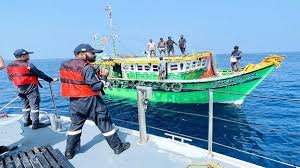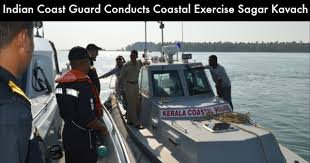The Indian Coast Guard (ICG) recently conducted the ‘Sagar Kavach’ coastal security exercise along West Bengal’s 158 km coastline on February 21-22, 2025. This two-day operation aimed to enhance the coastal security framework by involving multiple agencies in simulated threat scenarios. The exercise focused on refining Standard Operating Procedures (SOPs) and strengthening inter-agency coordination to counter potential threats along India’s eastern maritime border.
Simulated Threat Scenarios
The ‘Sagar Kavach’ exercise was meticulously designed to replicate real-life security threats, thereby assessing the preparedness of maritime forces. Key scenarios included:
- Hijacking Incidents: Simulations involved the hijacking of fishing boats and barges, mimicking potential terrorist landings and hostage situations.
- Smuggling Operations: Drills tested responses to illegal transportation of goods and contraband along the coastline, addressing known security challenges in the region.
- IED Threats: The exercise incorporated the detection and neutralization of improvised explosive devices (IEDs) planted on critical infrastructure such as ports and jetties.
By encompassing a wide range of security threats, the exercise ensured that all participating agencies were well-prepared for real-world contingencies.
Inter-Agency Collaboration
A significant aspect of the ‘Sagar Kavach’ exercise was the seamless coordination among various agencies. Led by the Indian Coast Guard, the operation saw active participation from:
- Maritime Patrols: The ICG, Indian Navy, West Bengal Police, Central Industrial Security Force (CISF), Border Security Force (BSF), and Customs conducted extensive patrolling across the coastline, establishing a robust multi-layered security presence.
- Coastal Surveillance: District police and forest department personnel enhanced on-ground monitoring, vigilantly observing for any suspicious activities.
- Community Engagement: Fishermen’s watch groups were mobilized as the “Eyes and Ears” of security forces, providing crucial grassroots intelligence on potential threats.
This collaborative approach not only bolstered the efficiency of security measures but also ensured cohesive action among all stakeholders.
Strategic Importance of West Bengal’s Coastline
West Bengal’s coastline holds strategic significance due to several factors:
- Extensive Maritime Community: The region is home to over 330,000 fishermen operating more than 16,000 fishing boats, adding complexity to security monitoring efforts.
- Critical Infrastructure: The presence of two major ports, numerous river ports, jetties, and a multitude of industries renders the area a potential target for security threats.
- Porous Borders: The unique riverine geography of the region presents challenges in monitoring unauthorized movements, underscoring the necessity of exercises like ‘Sagar Kavach’ to fortify coastal defenses.
The ongoing refinement of such exercises is integral to a broader strategy aimed at reinforcing coastal security. Previous iterations, including one held on September 25-26, 2024, have addressed similar challenges, exemplifying the Indian Coast Guard’s commitment to proactive defense initiatives.

Why This News is Important
The successful execution of the ‘Sagar Kavach’ exercise is pivotal for several reasons:
- Enhancing National Security: By simulating and preparing for potential maritime threats, the exercise fortifies India’s defense mechanisms against infiltration, smuggling, and terrorist activities.
- Strengthening Inter-Agency Coordination: The drill fosters improved collaboration among various security and enforcement agencies, ensuring a unified and effective response to coastal threats.
- Protecting Economic Interests: West Bengal’s coastline is a hub of economic activity, housing major ports and industries. Ensuring its security is vital for the uninterrupted flow of trade and commerce.
- Community Involvement: Engaging local communities, especially fishermen, in security protocols enhances vigilance and creates a collaborative environment for threat detection and prevention.
- Policy and Procedural Refinement: Insights gained from such exercises inform policymakers and lead to the continuous improvement of Standard Operating Procedures, adapting to evolving security dynamics.
For students preparing for government exams, understanding the significance of such exercises provides insight into India’s comprehensive approach to national security and the collaborative efforts of various agencies in safeguarding the nation’s interests.
Historical Context
The ‘Sagar Kavach’ exercise is a critical component of India’s coastal defense strategy, initiated to bolster maritime security in response to emerging threats. Historically, India’s extensive coastline has been vulnerable to various security challenges, including unauthorized infiltration, smuggling, and potential terrorist activities. The necessity for a coordinated and robust coastal security mechanism became particularly evident following incidents that exposed gaps in maritime surveillance and response.
In response, the Indian Coast Guard, in collaboration with the Indian Navy and other security agencies, instituted the ‘Sagar Kavach’ series of exercises. These drills are conducted periodically along different coastal regions to assess and enhance the effectiveness of existing security protocols. Each iteration of ‘Sagar Kavach’ incorporates lessons learned from previous exercises and real-world events, ensuring that India’s coastal defense strategies remain dynamic and responsive to evolving threats.
Key Takeaways from ‘Sagar Kavach’ Coastal Security Exercise
| S.No. | Key Takeaway |
|---|---|
| 1 | Comprehensive Threat Simulation: The exercise encompassed scenarios like hijackings, smuggling, and IED threats to test preparedness. |
| 2 | Multi-Agency Collaboration: Active participation from ICG, Navy, Police, CISF, BSF, and Customs ensured a unified security approach. |
| 3 | Community Engagement: Fishermen’s watch groups were integral, acting as informants to bolster grassroots surveillance. |
| 4 | Strategic Focus on West Bengal: Emphasis on securing the state’s extensive maritime assets and addressing challenges posed by its unique geography. |
| 5 | Continuous Improvement: Insights from the exercise are slated for high-level discussions to refine coastal security mechanisms and SOPs. |
Important FAQs for Students from this News
What is the purpose of the ‘Sagar Kavach’ coastal security exercise?
The exercise is conducted to enhance coastal security by simulating real-life threats and improving coordination among various maritime security agencies.
Which agencies participated in the ‘Sagar Kavach’ drill?
The Indian Coast Guard (ICG), Indian Navy, West Bengal Police, CISF, BSF, Customs, district police, and forest department personnel were involved.
What were the key threat scenarios tested during the exercise?
The drill focused on threats such as hijacking incidents, smuggling operations, and improvised explosive device (IED) threats.
Why is West Bengal’s coastline strategically important?
West Bengal’s coastline hosts major ports, economic hubs, and a large fishing community, making it crucial for trade, security, and law enforcement efforts.
How does this exercise contribute to India’s coastal security?
It helps refine Standard Operating Procedures (SOPs), strengthens inter-agency coordination, and involves local communities in surveillance efforts.
Some Important Current Affairs Links


















